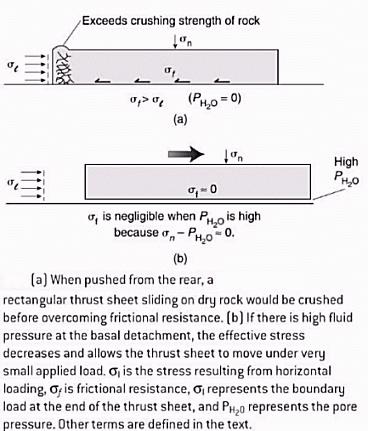OVERTHRUSTS
s
n: Normal stresss
t or t:shear stress.The overthrusting is guided by the Naviour Coulom criterion. It may be assumed that the thrust wedge is a granular aggregate in which component fragments slide past one another and behave Coulomb's criterion: i.e. shear stress equals the product of normal stress (minus p, pressure exerted by water in the pores that is
sp) times coefficient of internal friction plus unit cohesion. Stresses on the wedge are both horizontal (a push from the rear) and vertical (due to gravity). Gravitational force increases with the elevation of the hinterland from where the materail transport begins. In response to a push from the rear, the wedge deforms internally (by folding, faulting or general strain) and thickens, increasing the surface slope. The taper angle of the slope, f , is equal to the surface slope, a , plus the detachment angle, b. When the slope reaches alpha value that produces a critical taper angle, fc (ie. f critical), the wedge slides in a stable manner toward the foreland along the weak detachment surface. Movement occurs on the detachment because the coefficient of sliding friction on the detachment is less than the coefficient of internal friction for the wedge material. As the fault wedge moves forward, new material is added to the wedge at its toes as newer thrust faults form progressively toward the foreland (by break-forward thrusting into the footwall). This causes the taper to decrease to less than the critical taper, and sliding stops. This cycle is maintained by dynamic equilibrium among the addition of new material at the toe of the wedge (by break-forward thrusting), which decreases the surface slope. Internal deformation within the wedge due to formation of duplexes at the base of the wedge, out-of- sequence thrusting, folds, and penetrative strain, which increase the slope, and thinning of the wedge due to extensional deformation and erosion of the wedge, which decreases the surface slope. Ramping thrusts into the hanging wall block gives rise to out - of -sequence thrusts but examples of this kind of development are rare.